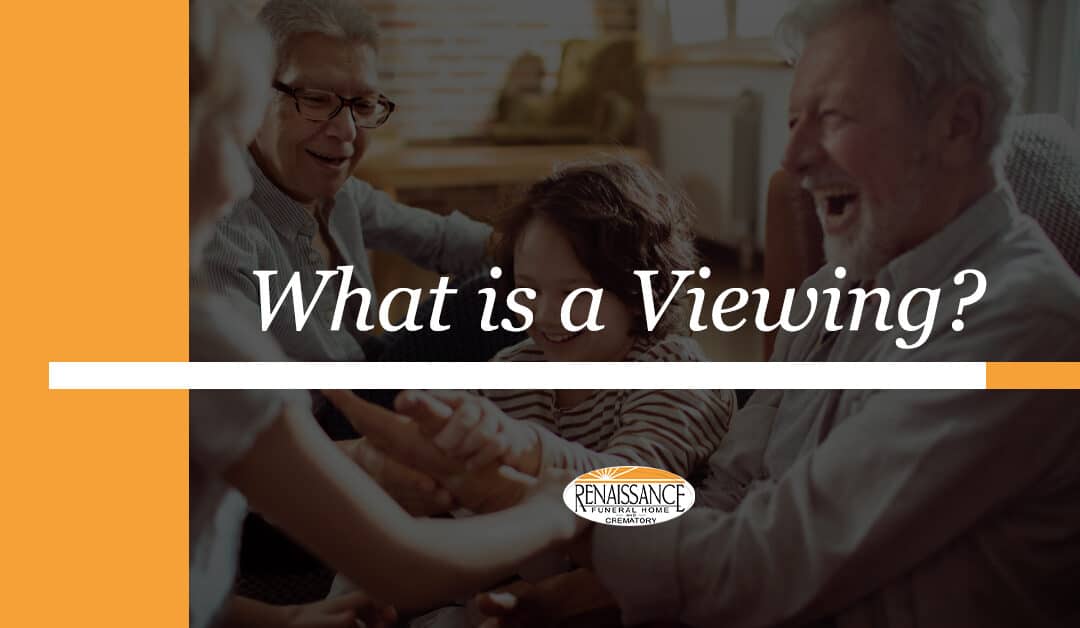When a loved one passes away, it’s a time filled with emotions, questions, and traditions. One common tradition is the viewing. But what is a viewing? Does this tradition have other names? In this blog post, we’ll explore what a viewing entails and how it can provide comfort during a time of grief.
What is a Viewing?
A viewing is an intimate gathering where family and friends have the opportunity to say goodbye to a loved one in a personal and meaningful way. This practice offers a chance to find closure, reflect on shared memories, and begin the healing process.
The tradition of a viewing goes by many different names. You may wonder about the differences between a wake vs visitation vs viewing. However, depending on cultural backgrounds and personal preferences, a viewing may go by any of these names and more.
Each of these terms describes the same essential practice but may carry subtle differences in meaning or tradition.
Next, let’s look at what generally happens at a viewing or wake in North Carolina.
What Happens at a Viewing in North Carolina?
In North Carolina, a viewing or wake is a time-honored tradition where friends and family come together to remember and honor the life of a deceased loved one.
Here’s what you can generally expect:
Visiting Hours
There may be specific hours for visitors to pay their respects. This allows friends, coworkers, and extended family members to stop by and offer condolences.
Often, a line will form as everyone waits their turn to walk by the casket and spend just a few moments to pay tribute to the deceased. The deceased’s family will often make a receiving line so that each person in line may offer their respects and share fond memories.
Personal Tributes
Guests may share stories and memories or bring photos or mementos that had meaning to the deceased. Some may choose to pray or engage in other spiritual practices.
Attire
Though it varies, the dress is typically more on the formal side, with subdued colors often considered most appropriate. However, if you attend a viewing, you may always ask the funeral home or family members about appropriate dress. The viewing may vary from a formal event to a more casual informal one at a family home.
Refreshments and Socializing
Depending on the family’s wishes, there might be refreshments and a chance for attendees to mingle and support one another. This time provides an opportunity to celebrate the life of the loved one and strengthen communal bonds.
Body Presentation
Often, the deceased’s body is embalmed and placed in a casket. Family members may choose an open or closed casket depending on personal or cultural preferences.
Respecting Cultural and Religious Beliefs
It’s essential to recognize that specific customs and practices might vary widely based on the deceased’s cultural or religious background.
The experience of a viewing or wake in North Carolina is shaped by a combination of universal human customs and American family traditions. It’s a chance to find closure, embrace community, and celebrate a life well-lived. If you ever find yourself attending one, know that your presence and sympathy are the most important things you can offer to the grieving family.
Origins of the Tradition
The practice of holding a viewing has deep historical roots. It’s a custom traced back to ancient civilizations, where families and communities would gather to honor the deceased. This practice allowed them to confirm the death, pay respects, and begin mourning together as a collective.
In many cultures, the viewing became a way to celebrate the life of the departed, share stories, and find support among friends and family.
Viewings have always been integral to American funeral traditions, reflecting a blend of cultural and religious influences. During previous eras, viewings were often held in family homes, where the deceased’s body would be prepared and laid out for visitors to pay their respects.
Home viewings often involved flowers to keep the home smelling nice despite a lack of embalming. With the emergence of funeral parlors in the 19th century, embalming and other preservation techniques brought families a new place to hold a viewing. Many families shifted to this more formal setting.
Over time, various ethnic and religious groups added unique practices to the tradition, enriching the viewing experience with rituals, prayers, music, and personal touches.
The viewing time continues to offer friends and family a place to gather, mourn, remember, and celebrate the life of a loved one.
Understanding the history and various names for a viewing can make this tradition feel even more meaningful. Knowing the roots of the customs we observe helps us connect to a shared human experience and provides comfort during difficult times.
Where Can I Have a Viewing?
The viewing may take place at a funeral home, church, or even a family home, with the space designed for comfort and reflection.
The choice of location for a viewing depends on various factors, including personal preferences, religious beliefs, the capabilities of the funeral home facility and the wishes of the deceased.
Regardless of the setting, the goal is to create a comforting space where family and friends can come together to share memories, find solace, and honor a life well-lived.
Funeral Home
A funeral home is often the go-to venue for viewings, offering a professional setting with staff experienced in handling all the necessary arrangements. They provide an environment tailored for remembrance and support, with options for both open and closed caskets.
Church or Other Religious Venue
For those with strong religious ties, a church or other religious venue may be preferred. This setting allows the incorporation of specific religious rituals, prayers, or hymns that may hold significant meaning to the deceased and their family.
Family Home
Choosing a family home for a viewing adds a deeply personal touch. It allows the family to create an intimate and familiar setting that reflects the loved one’s life and personality. Having the viewing at home can foster a more relaxed environment and provide a unique opportunity for reflection and connection among those who knew the deceased best.
Can a Funeral Service Include a Viewing?
In North Carolina, it’s not uncommon for a funeral service to include a viewing. This practice allows friends and family to gather and pay their respects to the deceased before or during the funeral service.
Here’s how it generally unfolds:
Combination of Traditions
Many families choose to incorporate a viewing as part of the funeral service, seamlessly blending the opportunity for personal reflection with more formal religious or secular ceremonies. This combination can provide a comprehensive and meaningful farewell.
A funeral ceremony may start with the closing of the casket and the beginning of the formal service.
Timings and Logistics
The viewing can occur right before the funeral service, allowing attendees to gather, reminisce, and support one another. Depending on the family’s preferences and the community’s practices, it can also be scheduled for the evening before.
Open or Closed Casket
Depending on personal beliefs, cultural background, and the deceased’s wishes, the casket may be open or closed during the viewing. Both options are common and are typically guided by the family’s comfort level.
Inclusion of Personal Touches
Families often include personal touches during the viewing, like displaying photographs, favorite belongings, or even playing cherished music. These elements make the viewing a unique reflection of the person’s life and passions.
Religious funerals may include prayers or scripture readings during a funeral service or before or after a viewing.
Guidance from Funeral Directors
Local funeral directors are well-versed in cultural and religious traditions in your area. They can guide families on how to include a viewing as part of the funeral service. Their experience and understanding of local customs can ensure that the process is handled with care and respect.
A viewing is a flexible and meaningful component that can be integrated into a funeral service. It offers an intimate space for personal connection, respects cultural norms, and adds depth to commemorating a loved one’s life.
By considering the family’s preferences and local traditions, a viewing can enhance the funeral service and comfort those in mourning.
Memorial Service vs Funeral: What’s the Difference?
Understanding the differences between a memorial service and a funeral can help families make the right choice for honoring a loved one. Many individuals use these terms interchangeably, but they refer to distinct ceremonies.
Memorial Service
A memorial service is typically held without the deceased’s body. This service can take place weeks or even months after the death. This gives time for family and friends to gather. The focus is on celebrating and remembering the life of the deceased.
- Flexibility: Since the body is not present, there’s more flexibility in timing and location.
- Personalization: Families can tailor the service to reflect the personality and interests of the deceased.
- Casual Atmosphere: Memorial services often have a more relaxed and informal tone.
Funeral Service
A funeral service is a more traditional ceremony. It usually includes the deceased’s body in a casket or an urn if cremated.
- Timing: Funerals typically occur within a week of the death, following specific cultural or religious guidelines.
- Location: Often take place in a funeral home, church, or other religious venue and may include a graveside service.
- Formality: Funerals tend to be more formal, with structured proceedings that might include readings, prayers, and hymns.
Key Differences for Funeral Ceremonies vs Memorials
- Presence of the Body: This is the most notable difference. The body is present at a funeral and absent at a memorial service.
- Timing and Flexibility: Funerals usually occur within the week after death. Memorial services are often more convenient for attendees, sometimes a month or more after death
- Tone and Atmosphere: Funerals often have a more solemn and formal manner, while memorial services may be more celebratory or casual.
Choosing between a memorial service and a funeral depends on various factors. These may include family preferences, religious beliefs, and cultural traditions. Both services honor a loved one, but each offers different approaches and atmospheres. Understanding these differences can help families create a meaningful and fitting tribute.
Our Funeral Home Can Help Your Family Create a Meaningful Tribute
At Renaissance Funeral Home and Crematory, we understand that each life is unique and worth celebrating. We help your family create a personalized tribute that reflects the individuality of your loved one.
Whether you choose a traditional funeral service, a more casual memorial, or anything in between, our compassionate and experienced team is here to guide you every step of the way. From selecting the perfect venue to incorporating special touches that honor your loved one’s passions and personality, we provide support, empathy, and expertise.
Our dedication to serving families in their time of need has shaped us into a trusted community partner, always ready to assist in crafting a meaningful and comforting farewell.


